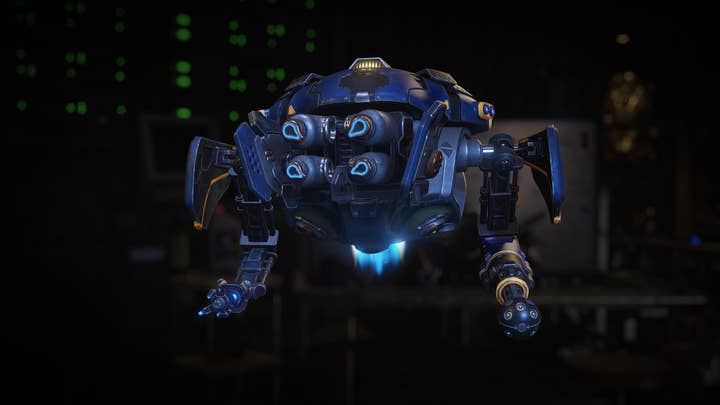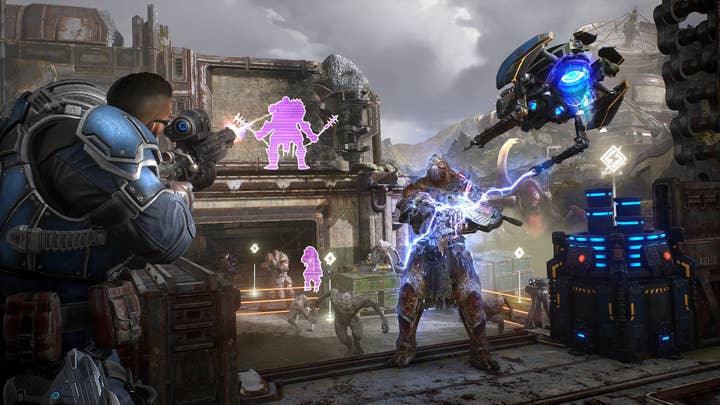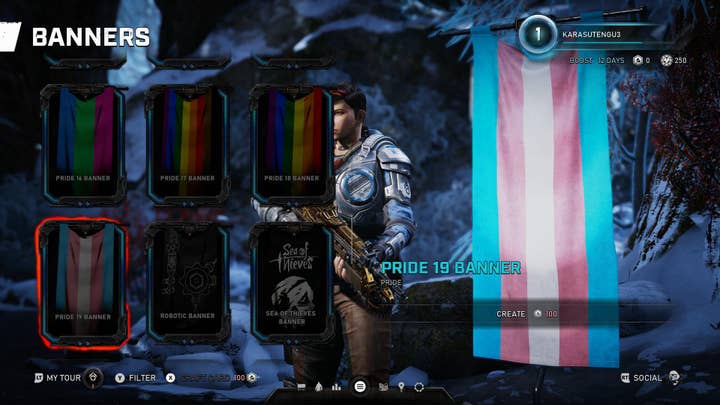Making Gears of War click for more than the hardcore
The Coalition studio head Rod Fergusson's MIGS keynote talked about changes made in the name of broader appeal
The recent release of Gears 5 may be seen as a return to prominence for the long-running third-person shooter franchise, but The Coalition studio head Rod Fergusson said the focus was on evolution. Delivering the keynote address at the Montreal International Game Summit today, Fergusson said the focus for the game was always about introducing Gears to a broader audience.
"Gears is known as being a pretty hardcore franchise," Fergusson said. "I think Gears has the most number of people with tattoos of any game franchise I've seen in my life. And when this is your audience, how you think about expanding that to be a little more mainstream or more approachable is always a challenge."
Fergusson noted that the game was going to get more people trying it than usual just by its day-one inclusion in Microsoft's Xbox Game Pass subscription program.
"Before there was a $60 barrier, where you go, 'Do I want that game?'... But now this little tile was going to light up in their library for millions and millions of people," Fergusson said. "So how do we welcome these people? These are people who maybe have no idea what Gears of War is."

To keep them from bouncing off the game immediately, Fergusson said The Coalition's focus was on inclusive design, expressing fondness for one particular maxim he'd heard: "Unless you consciously include, you will unconsciously exclude."
"If you just do what you're doing without thinking about how to include others, your normal biases are going to kick in and you're going to forget people just because they're not part of your social circle, not part of your demographic," Fergusson said. "You're not thinking about them. It's just a reminder that if you want to include and grow your audience, you have to be very explicit about how you do that."
"If you just do what you're doing without thinking about how to include others, your normal biases are going to kick in"
Another common tenet of inclusive design that Fergusson embraced was the idea of solving problems for one person, and then extending the benefits of that solution to the rest of the player base. There were three specific areas where Fergusson stressed the importance of inclusive design: approachability, accessibility, and diversity.
On approachability, Fergusson pointed to the addition of Jack, a robot support character. Originally, Jack was introduced as a way to add character progression to the game.
"We wanted to add RPG elements to Gears 5 but we didn't want to change the characters," Fergusson said. "The characters are pretty much set in Gears. We didn't want to say, 'Well now she can run faster, or now she can shoot straighter.' We didn't want to put it on the character, so we put it on the robot."
Before long, they began thinking about making Jack playable and opening up a three-player co-operative mode using it. Fergusson said they took inspiration from Super Mario Galaxy, where a second player can use a Wii Remote pointer on the screen to assist Mario by picking up star bits and firing them at enemies.

"As we thought about how we would deal with this from a beginner's perspective, we realized that the best way to deal with things as a beginner is to do everything sort of counter to what is the core of Gears," Fergusson said.
Taking cover is essential in Gears of War, but it means players have to think about how and when they can get around the battlefield safely. Jack just floats above the terrain anyway, so players don't need to worry about it. The team reasoned lining up crosshairs for headshots was another task that might be second-nature to hardcore gamers but difficult for newcomers, so they made Jack's abilities area-of-effect rather than anything requiring pixel-perfect precision.
"So we purposely created this character whose abilities and movement were the exact opposite of what the main game is like, so that it would have a different way of playing," Fergusson said.
"A simple thing like allowing people to change the size of a font in a caption can open a world to a different player"
Fergusson said Jack was appreciated not just by the newcomers, but also by the core Gears crowd, particularly in the game's online co-op Horde mode. He pointed to one player's feedback that playing as Jack in Gears 5 was like being a drummer: "You're always wanted."
"That was a big part of the ecosystem," Fergusson said. "We took something most beginners would play in Jack, and now Jack is wanted. People would welcome a Jack player -- 'Play with us, we need a Jack!' -- so it made it a lot more friendly and welcoming ecosystem."
On the accessibility front, Fergusson noted Microsoft's Games for Everyone initiative and the adaptive controller, but he also talked about the importance of an "inclusive design sprint," a two-day session in which the company brought people with disabilities and subject experts in to consult on the game and give the team feedback on their challenges.
Fergusson said some of the feedback was relatively trivial to incorporate but made a big difference for players. For example, the Gears games have always played a distinctive guitar riff at the end of a combat sequence to let players know they can relax a little, but Gears 5 was the first time the subtitles would reflect that with a "music settles" message for hard of hearing players. Subtitles also now note who's talking, if someone is off-screen, and what emotion they might have in their voice. The game also lets people choose the font size and the background color of the subtitles, and Jack's different set of abilities and movements opened the door to simplified controls that could help some disabled gamers.

Gears 5's suite of accessibility options was enough to garner a perfect six out of six deaf review score from accessibility-minded gaming site Can I Play That? Microsoft included that in the game's accolades trailer, alongside a slew of high scores from mainstream outlets. Fergusson liked the idea of accessibility as a mainstream quality, but acknowledged it isn't yet.
"Even after us, there have been a number of games that have come out that have done it wrong, in terms of text being so small that even I can't read it on a 4K TV of decent size," he said. "There are people who just don't understand that a simple thing like allowing people to change the size of a font in a caption can open a game up, and open a world to a different player. And it's sad that's still happening today, but at least the conversations are happening."
"It's this thick-necked, testosterone-filled, gory shooter that's trying to do all these things that are new and different"
Fergusson's third major focus for inclusive design was diversity. Two months before launch, he said he asked the team in charge of the game's multiplayer banners if they had a rainbow pride banner. They said they planned to get around to it a couple months after launch, but Fergusson pushed them to get it done quicker, reasoning banners would be relatively easy to add. The team consulted with Microsoft's internal GLEAM (Global LGBTQ+ Employees and Allies at Microsoft) team, which said there were actually 19 separate flags representing a variety of marginalized identities. The Coalition included all of those for launch, and plans to add a 20th pride flag in the near future.
"Initially we anticipated this could be a problem for us, because we're a global company, an international company, and the rights of [LGBTQ+] people are not the same throughout the world," Fergusson said. "We were a little bit nervous about what we were supposed to do."
Fergusson said he brought the issue up with his boss, Matt Booty, and his boss' boss, Phil Spencer, saying this was how he wanted to handle the flags. (The biggest concession made for international sensibilities was that the various flags were included listed as "Pride 19 Banner," for example, rather than "Transgender Pride Flag" or whatever specific group the flag was expressing pride about.)

On top of that, The Coalition didn't make the pride flags a point of pride during the game's marketing campaign. Awareness of their existence was instead spread through players spotting them in the game, recognizing them, and posting about them on social media.
"We didn't talk about this ahead of time because that's not for us," Fergusson said. "It's only for people who care about those things. It's their community; it's there if they want."
Ultimately, Fergusson said the great thing about all these changes in the name of approachability, accessibility, and diversity is that they were taking place in something that had traditionally been regarded as a hardcore franchise.
"It's this thick-necked, testosterone-filled, gory shooter that's trying to do all these things that are new and different," Fergusson said. "And it's just because we were trying to be more inclusive of our players because we knew we were going to have this large audience of new players coming in."
And by the metrics available, it appears The Coalition's strategy has paid off.
"Gears 5 was the biggest launch for any Xbox Game Studios game this generation," Fergusson said. "And we think a lot of that has to do with the fact we had such an outreach to different communities and we were trying to be so welcoming to the players out there, saying, 'Please come and try Gears. We know you'll love it.'"
Disclosure: MIGS provided travel and accommodations for GamesIndustry.biz to attend the event.
